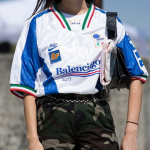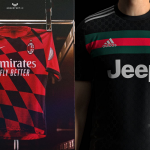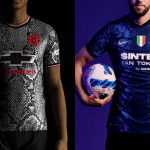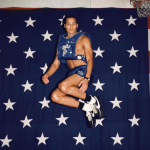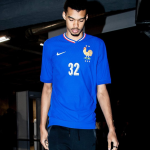
How virtual concept kits are influencing jersey design
We talked about it with Sett Pace and three other designers linked to the virtual kit subculture
August 4th, 2021
Watching the releases of the upcoming football season, many fans and followers have had a strange feeling of Matrix-like deja vu. Most of the most innovative designs like Inter’s snakeskin home or Barcelona’s iridescent away seem to have come straight out of an IG feed of the so-called concept kits designers. "For those who come from the world of amateur kit design, Inter, Barcelona and Spurs shirts are all things we have seen before," as Alberto Mariani aka Rupertgraphic, one of the Italian exponents of this strange and increasingly influential creative movement, pointed out. For those who are not familiar with the term, concept kits are amateur proposals created by designers out of passion and then published on social platforms. Few years ago they were a small group of football shirt enthusiasts that were throwing visionary virtual shirt online, today - due to social media, the explosion of online gaming and the football-fashion trend - this little niche has bubbled into the mainstream influencing the of a huge industry like football, in a strange reversal of imitation between reality and virtual.
"The concept kits helped push things forward and show brands what is possible. That was my main goal in the beginning to grab people's attention and move things forward". We were told by Marlon Feeney aka Sett Pace, one of the pioneers of the movement and one of the most followed. It was he who predicted a Marcelo Burlon collaboration on a football shirt and - above all - the trend of iridescent colourways, now present on the away shirts of Barcelona and Manchester City. The most interesting aspect of the issue is the inversion of the causality between the virtual and the real: video games were born with the aim of digitally representing reality, today instead it is reality that runs after the virtual in a short circuit even at a technical level, as Emanuele Atturo wrote on Ultimo Uomo. We are not just talking about virtual fashion, FIFA had implemented it some time ago, also employing designers with a name like Angelo Trofa, today we are talking about giving materiality to ideas and concepts that were born, thought and consumed on digital platforms. Among the first experiments were the four jerseys - one of which was iridescent, as chance would have it - made by FIFA and adidas for the four top clubs: Juventus, Bayern Munich, Real Madrid and Manchester United. It was a flop, the market for performance football shirts was not yet ready for such a profound aesthetic overhaul, even though street-style photos in Milan, Seoul and Paris were beginning to show football shirts re-interpreted as fashion items.
FIFA then went back to virtual, enhancing the possibility of customising jerseys within the game to the point of developing VOLTA, a mode in which - as in the streetwear world - virtual collections signed by great football-fashion bishops such as Hector Bellerin or the New York collective Fly Nowhere are spiked. While the fashion and gaming worlds were bubbling over with this revolution, the football industry was ignoring or avoiding these cultural and aesthetic changes that had little to do with the sport being played. In fact, if we look at the evolution of football shirt design, we can say that in the last ten years there have been no changes or particular aesthetic or material evolutions. There are obviously some excellent exceptions - PSG being one of them - but considering the world of budget land very few brands and clubs wanted to run the risk of changing an object considered sacred as well as being a secondary revenue stream but still important for both. Football - and its audience - is an aesthetically traditional industry, living on nostalgia and memories, where changing symbols and traditions is perceived as an attack on identity.
After years of basic templates, revamps of old shirts and minimal variations in fit and colourway, innovation in the market is coming from amateur graphic designers who were outside or on the fringes of the industry and have managed to exploit the avenue opened up by the football-fashion trend, surfing the growth of gaming and general interest in football shirts. Instagram played an important role, where a large proportion (if not the majority) of Manchester United's 42 million followers became attached to the team by playing FIFA or PES, thus admiring the virtual jerseys much more than the real ones. This segment of the population raised on bread and video games is the same one that experienced the streetwear boom, which especially in Asia but also in America means logomania. These two macro processes have created the perfect scenario for concept kits on Instagram: when an unknown graphic designer posted a concept of a fancy PSG x Louis Vuitton kit on his feed, it was easy to trigger social discussions: it is divisive content, attracting masses of fans ready to despise the fancy kit and just as many users ready to tag the psg to ask if it is a fake. Most likely, the trend of fake collaborations that reached its peak in 2018, inspired the one between Palace, adidas and Juventus, arriving then to the declared inspiration as in the cases of Marcelo Burlon x Napoli and especially Brain-Dead x AS Roma, where the operation reads the real-virtual short-circuit in an ironic way.
Many of these graphic designers are aware of these mechanisms and the progressive accessibility of virtual customisation programmes - one example above all is the Virtual Kit - has attracted more and more young people and non-professionals. Not only fans and enthusiasts are looking at the concept kits, but also brand and club insiders, as confirmed by Marco Dal Bon, better known as Emmegraphic, "it hasn't gone unnoticed by insiders, who have inevitably been influenced by the increasingly exotic and elaborate designs that have populated the various social networks to the point of almost wanting to reflect what the community has enhanced directly on the playing fields, riding the wave".
When Andrea Agnelli presented the Superleague, he said that "Fortnite is our competitor", and there is some truth in what he says. The mistake lies in thinking of engaging in a battle between real and virtual, while instead it is possible to synthesize them by giving a materiality to what is composed of algorithms and graphics. As Jaime Canas aka SOCCEPT said, "concept kits were born to break the mainstream, over the years they have shown that you can really innovate a football shirt".



















